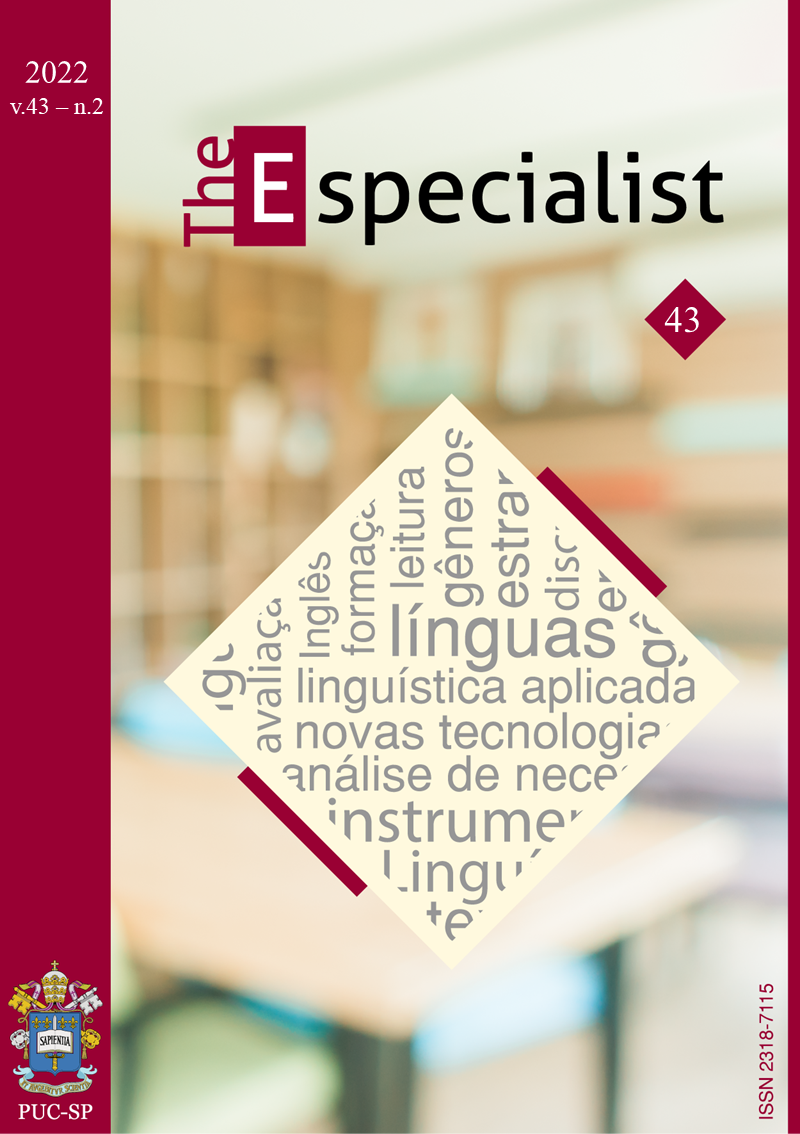English for Academic Purposes in a Brazilian Public Higher Education Institution
a needs' analysis survey
DOI:
https://doi.org/10.23925/2318-7115.2022v43i2a7Keywords:
English for Academic Purposes, Case Study, Needs AssessmentAbstract
This study focuses on raising the profile and needs of a Brazilian public Higher Education Institution (HEI) regarding the planning, program design, choice of courses, selection, and development of materials for English for Academic Purposes (EAP). The research is a case study comprising an online questionnaire with 346 respondents, about the community's experiences and needs regarding English in an academic context. The results revealed that respondents aged between 20 and 30 years (73.6%), the prevalence of the female sex (68.7%), in the categories of undergraduate (52%) and graduate students (44.3%) perceive EAP as extremely important (74.3%) to read academic articles (96.6%), books and chapters (92.2%), attend lectures (72.4%) as well as write abstracts (71.0%). The data obtained is expected to improve the HEI's IFA proficiency.
Keywords: English for Academic Purposes, Case Study, Needs Assessment, Academic English
References
AUGUSTO-NAVARRO, E. H. et al. 2016. Desenvolvimento de materiais didáticos para o Programa IsF: consideração de necessidades prementes, do contexto e da formação de professores. In: S. SARMENTO; D. ABREU-E-LIMA; W. MORAES FILHO (Orgs.), 2016. Do Inglês sem Fronteiras ao Idiomas sem Fronteiras. Belo Horizonte: Editora UFMG, pp. 249-271.
BELCHER, D. D. 2004. Trends in teaching English for specific purposes. Annual review of applied linguistics, 24. 1: 165-186.
BIBER, D. 2006. University Language – A corpus-based study of spoken and written registers. Amsterdam/Philadelphia: John Benjamins Publishing Company.
BIBER, D. et al. 2009. Register, genre, and style. Cambridge: Cambridge University Press.
BRASIL. 2014. Ministério da Educação. Portaria n. 973, de 14 de novembro de 2014. Instituto o Programa Idiomas sem Fronteiras. Disponível em: http://isf.mec.gov.br/images/pdf/novembro/Portaria_973_Idiomas_sem_Fronteiras.pdf. Acesso em: 16 fev. 2021.
BRASIL. 2012. Ministério da Educação. Portaria n, 1.466, de 18 de dezembro de 2012. Disponível em: http://isf.mec.gov.br/documentos Acesso em: 09 agosto, 2022.
BRASIL. 2011. Decreto n. 7.642, de 13 de dezembro de 2011. Institui o Programa Ciência sem Fronteiras. Disponível em: https://legislacao.presidencia.gov.br/atos/?tipo=DEC&numero=7642&ano=2011&ato=b76IzYU9UMVpWTb73. Acesso em: 16 fev. 2021.
DE SOUZA ARAÚJO, M. 2015. Inglês para fins específicos: o desenho de um curso a partir da análise de necessidades. Intercâmbio, São Paulo, 30: 51-79.
DUDLEY-EVANS, T. et al. 1998. Developments in English for specific purposes: A multi-disciplinary approach. New York, Cambridge University Press.
FLOWERDEW, J. 2019. The linguistic disadvantage of scholars who write in English as an additional language: Myth or reality. Language Teaching, 52. 2:. 249-260.
FLOWERDEW, L. 2013. 17 Needs Analysis and Curriculum Development in ESP. The handbook of English for specific purposes, pp. 325.
HOLMES, J. ; CELANI, M. A. A. 2006. Sustainability and local knowledge: The case of the Brazilian ESP Project 1980–2005. English for Specific Purposes, 25. 1: 109-122.
HUTCHINSON, T.; WATERS, A. 1987. English for Specific Purposes. Cambridge: Cambridge University Press.
HYLAND, K. 2006. English for Academic Purposes: an advanced resource book. New York: Routledge.
HYLAND, J. ; SHAW, P. (Ed.) 2016. The Routledge handbook of English for academic purposes. New York: Routledge.
JORDAN, R. R. 1997. English for academic purposes: A guide and resource book for teachers. Cambridge: Cambridge University Press.
MCMANUS, C. ; NOBRE, C. 2017. Brazilian scientific mobility program-science without borders-preliminary results and perspectives. Anais da Academia Brasileira de Ciências, 89. 1: 773-786.
MUKHROJI, M. 2020. Exploring the Academic Writing Needs to Improve the Academic Literacy of the Indonesian EFL Undergraduate and Masters Students. International Journal of Innovation, Creativity and Change, 10, 10: 252-269.
ROBINSON, P. C. 1980. ESP (English for Specific Purposes): the present position. Oxford: Pergamon Press.
STREVENS, P. 1988. ESP after twenty years: a re-appraisal. In: M. L. TICKOO (Ed.), 1988. ESP: state of the art. SEAMEO Regional Language Centre (Anthology series 21).
VIANA, V. ; BOCORNY, A. E. P.; SARMENTO, S. 2018. Teaching English for Specific Purposes. ELT Development Series. TESOL Press. Available from: TESOL International Association. 1925 Ballenger Avenue Suite 550, Alexandria, VA 22314.
WEST, R. 1994. “Needs analysis in language teaching”. Language teaching, 27: 1-19.
WINGATE, U. ; TRIBBLE, C. 2012. The best of both worlds? Towards an English for Academic Purposes/Academic Literacies writing pedagogy. Studies in higher education, 37. 4: 481-495.
YIN, R. K. 1994. Case study research: design and methods. 2. ed. London: Applied social research methods series, SAGE Publications, v. 5.
YUVAYAPAN, F.; BILGINER, H. 2020. Identifying the needs of postgraduate students: The first step of academic writing courses. Dil ve Dilbilimi Çalışmaları Dergisi, 16. 2: 595-611.
Downloads
Published
How to Cite
Issue
Section
License
Copyright (c) 2022 The ESPecialist

This work is licensed under a Creative Commons Attribution 4.0 International License.
The authors grant the journal all copyrights relating to the published works. The concepts issued in signed articles are the absolute and exclusive responsibility of their authors.


 Esta obra está licenciada com uma Licença
Esta obra está licenciada com uma Licença 